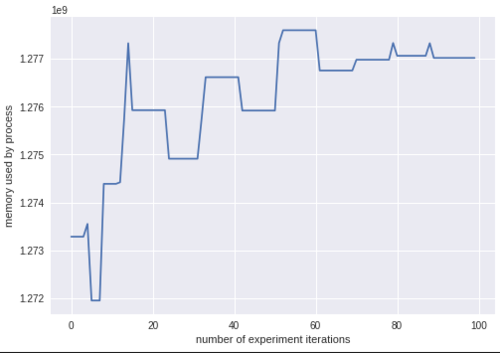在循环中构建图时,Tensorflow 内存泄漏
当我选择 Tensorflow(1.12.0 版)模型的超参数的网格搜索由于内存消耗激增而崩溃时,我注意到了这一点。
请注意,与此处类似的问题不同,我确实关闭了图形和会话(使用上下文管理器),并且我没有向循环中的图形添加节点。
我怀疑 tensorflow 可能维护了在迭代之间不会被清除的全局变量,所以我在迭代之前和之后调用了 globals() 但在每次迭代之前和之后没有观察到全局变量集的任何差异。
我做了一个重现问题的小例子。我在循环中训练一个简单的 MNIST 分类器并绘制该过程消耗的内存:
import matplotlib.pyplot as plt
import os
os.environ['TF_CPP_MIN_LOG_LEVEL'] = '3'
import psutil
import tensorflow as tf
from tensorflow.examples.tutorials.mnist import input_data
process = psutil.Process(os.getpid())
N_REPS = 100
N_ITER = 10
mnist = input_data.read_data_sets("MNIST_data/", one_hot=True)
x_test, y_test = mnist.test.images, mnist.test.labels
# Runs experiment several times.
mem = []
for i in range(N_REPS):
with tf.Graph().as_default():
net = tf.contrib.layers.fully_connected(x_test, 200)
logits = tf.contrib.layers.fully_connected(net, 10, activation_fn=None)
loss = tf.reduce_mean(tf.nn.softmax_cross_entropy_with_logits(labels=y_test, logits=logits))
train_op = tf.train.AdamOptimizer(learning_rate=0.0001).minimize(loss)
init = tf.global_variables_initializer()
with tf.Session() as sess:
# training loop.
sess.run(init)
for _ in range(N_ITER):
sess.run(train_op)
mem.append(process.memory_info().rss)
plt.plot(range(N_REPS), mem)
结果图如下所示:

在我的实际项目中,进程内存从几百 MB 开始(取决于数据集大小),直到我的系统内存不足为止增加到 64 GB。我尝试了一些减缓增长的方法,例如使用占位符和 feed_dicts 而不是依赖 convert_to_tensor。但持续的增长仍在那里,只是变慢了。
 手掌心
手掌心2回答
-

智慧大石
尝试在会话中进行循环。不要为每次迭代创建图形和会话。每次创建图形并初始化变量时,您不是重新定义旧图形,而是创建导致内存泄漏的新图形。我遇到了类似的问题,并且能够通过在会话中进行循环来解决这个问题。从如何不编程 Tensorflow在创建操作时要注意,并且只创建您需要的操作。尽量保持运算创建不同的运算执行。特别是如果您只是使用默认图形并在常规 REPL 或笔记本中交互运行,则最终可能会在图形中出现大量废弃的操作。每次重新运行定义任何图形操作的笔记本单元时,您不仅仅是在重新定义操作,而是在创建新操作。
 随时随地看视频慕课网APP
随时随地看视频慕课网APP
相关分类

 Python
Python